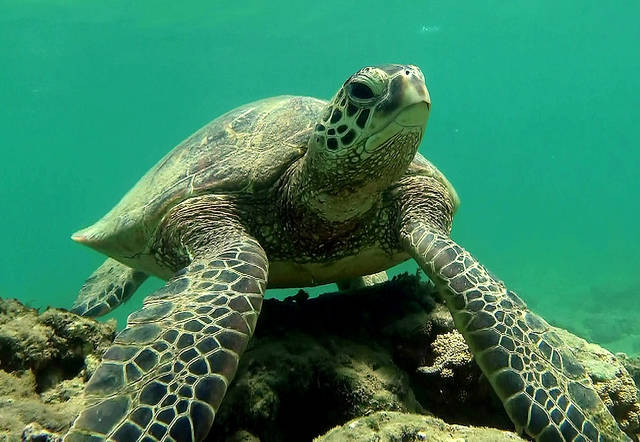LIHUE — As the Hawaiian green sea turtle nesting season wraps up, experts say it’s too early to tell if drastic changes on a remote island have affected the species.
“We just finished our turtle nesting season on Maui, so we need to see the beach conditions next summer,” said Hawaii Department of Land and Natural Resources Division of Aquatic Resources biologist Skippy Hau.
East Island has been making headlines worldwide as the island that disappeared underwater after a hurricane crossed directly over it on Oct. 3 and 4. While it is a critical sea turtle nesting site, biologists say the nesting season was complete on the island before the hurricane hit.
Green sea turtle nesting season starts in summer and wraps up in October.
“Nesting began in late summer, the first nest was laid on Aug. 28,” Hau said.
While green sea turtles are found throughout the world in subtropical waters, National Oceanic and
Atmospheric Administration scientists point out that Hawaiian green sea turtles are genetically distinct from other populations.
They nest primarily in the French Frigate Shoals of the Northwestern Islands, within the Papahanaumokuakea Marine National Monument.
The species population was in a nose-dive in the 1970s due to the harvesting of eggs and turtles by humans, according to NOAA. Federal protection began in 1978, and since then, the population has increased 53 percent.
The turtles eat algae and live to be around 70 years old. NOAA scientists say they don’t reach sexual maturity until 25 or 35 years of age, and females lay six clutches of about 100 eggs every two or three years.
Most of the turtles seen on Kauai are the Hawaiian green sea turtles, or honu, but they’re not the only type of sea turtles that are encountered here.
“We also have hawksbill, or honu ea, which has a pointed beak,” Hau said. “Honu, or green turtle, are threatened while honu ea, or hawksbill turtle, are endangered.”
Seeing a turtle basking on the beach on Kauai is a common occurrence. Sometimes they can even be seen alongside Hawaiian monk seals at places like Poipu Beach Park.
Often, the area around the animals are roped off, with signs advising people to keep a distance from the monk seal. That rule goes for honu in Hawaii, too, and it’s a law that results in a fine if broken.
It’s against the law to do anything that disturbs the natural behavior of honu or monk seals — it doesn’t matter if the animal is on the beach or in the water. People must maintain at least a 15-foot distance from the animal and watch it from there.
“Turtles will surface to breathe, so swimmers need to give them room to swim, or on the beach as they rest and bask on beaches,” Hau said. “Whatever someone does, they should not alter their natural behavior. That includes no petting or feeding.”
In other words, it’s acceptable to watch the turtles, just not to disturb them or harass them. Do not use lights when capturing images or videos of the animals.
Hatchlings typically emerge from their nests at night and use moonlight to guide them to the ocean, according to NOAA. That’s why officials ask the public to avoid driving on the beach during nesting season, and to limit lighting when on the beach at night.
•••
Jessica Else, environment reporter, can be reached at 245-0452 or jelse@thegardenisland.com.


